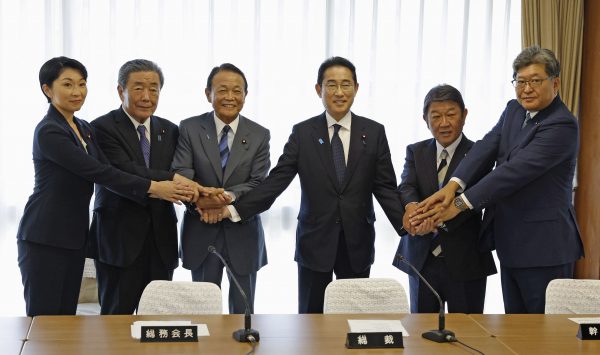Japan’s Prime Minister, Fumio Kishida, reshuffled his cabinet and key positions within the ruling Liberal Democratic Party (LDP) in September 2023, with limited impact on his overall support rate.
Examination by commentators has revealed Kishida’s approach to the new appointments. Among the major LDP factions — the Seiwakai faction, the Heisei Kenkyukai faction and the Shikokai faction were given favourable treatment. Heisei Kenkyukai faction leader Toshimitsu Motegi was reappointed as LDP Secretary-General and Shikokai faction leader, Taro Aso, was as LDP Vice President.
The new appointments within the LDP secretariat reflect Kishida’s desire to exert firm control over his party. Former deputy chief cabinet secretary Seiji Kihara was appointed as a Special Assistant to the LDP Policy Research Council Chairman.
Those close to former prime minister Yoshihide Suga secured only a few significant positions. Even the reappointment of Taro Kono has been widely regarded as a move to contain Kono within the Cabinet, limiting his ability to run in the 2024 LDP presidential contest.
Kishida is positioning himself as a contender for the post of the LDP president and prime minister in the upcoming election. Toshihiro Nikai, a powerful LDP secretary-general during the second Shinzo Abe administration and a key supporter of Yoshihide Suga, has been sidelined. Another former LDP secretary-general, Shigeru Ishiba, a potential prime ministerial candidate, was not appointed to a key position. This is despite his potential to change the public’s impression of the new appointments and improve the Kishida administration’s support rate. This decision is reportedly influenced by Aso, who holds grudges against Ishiba for disloyalty during Aso’s premiership.
Japan’s weak opposition parties enhance Kishida’s approach. Kishida’s stagnant support rate has not been significantly leveraged by Japan’s largest opposition party, the Constitutional Democratic Party. The Japan Innovation Party has significantly increased its support base, but has not established a strong national profile. The opposition parties have failed to form a unified front against the Kishida administration.
Kishida’s new appointments can reveal an approach to governance different from that of the second Abe administration. Under the second Abe administration, the power of Abe and the Kantei (Prime Minister’s Office) was a key factor in their domination of policy-making processes.
The Kantei under the subsequent Suga administration looked different. Its prime ministerial executive seemed to be independently connected to Suga. Members of Suga’s Kantei left little evidence of their effectiveness as a team.
Kishida’s Kantei exhibits similarities to Suga’s. Observers suggest that Kihara has exercised significant influence over key policy-making processes, akin to Abe’s executive secretary, Takaya Imai. Politicians close to Kishida frequently advise Kishida on important issues.
Unusually, Kishida has retained the leadership of his own Kochikai faction — the fourth largest in the LDP. Unlike Abe, who enjoyed the support of the largest LDP faction — the Shikokai Faction — Kishida needs the support of all major LDP factions, in addition to his own.
Before 1994, Japan’s House of Representatives used the single non-transferable voting electoral system. Under this system, LDP factions dominated the Party’s internal politics, forming clientelist groups and controlling rank-and-file members by supplying funds and allocating government and LDP posts.
Many researchers and politicians have argued that LDP internal politics, once dominated by the factions, has changed with the introduction of the single-member district system in the House of Representatives and political party grants. A growing number of LDP politicians, such as Sanae Takaichi, who competed with Kishida in the 2021 LDP Presidential contest, are choosing not to join a faction, as they likely find no substantial benefit in doing so. The LDP’s funding is now allocated to the rank-and-file by Kishida.
LDP factions today differ from those before 1994, which supplied appointments and funds through robust clientelist relationships as the Party’s main driving force. Now they seem to focus on appointments and electoral support with less strong networks, although the factions sometimes offer limited financial support.
Though the second Abe administration paid attention to LDP factional politics, its key agenda appeared to be firmly controlled by the Kantei. Reports on the Kishida administration and political developments today focus on power relations between LDP factions and Kishida himself, not the Kantei.
This coincides with the change in the influence of actors. Understanding the nature of Kishida’s administration is crucial to understanding the key developments in Japanese politics today.
Masahiro Mogaki isCollaborative Research Fellow, Keio Economic Observatory, Keio University.

